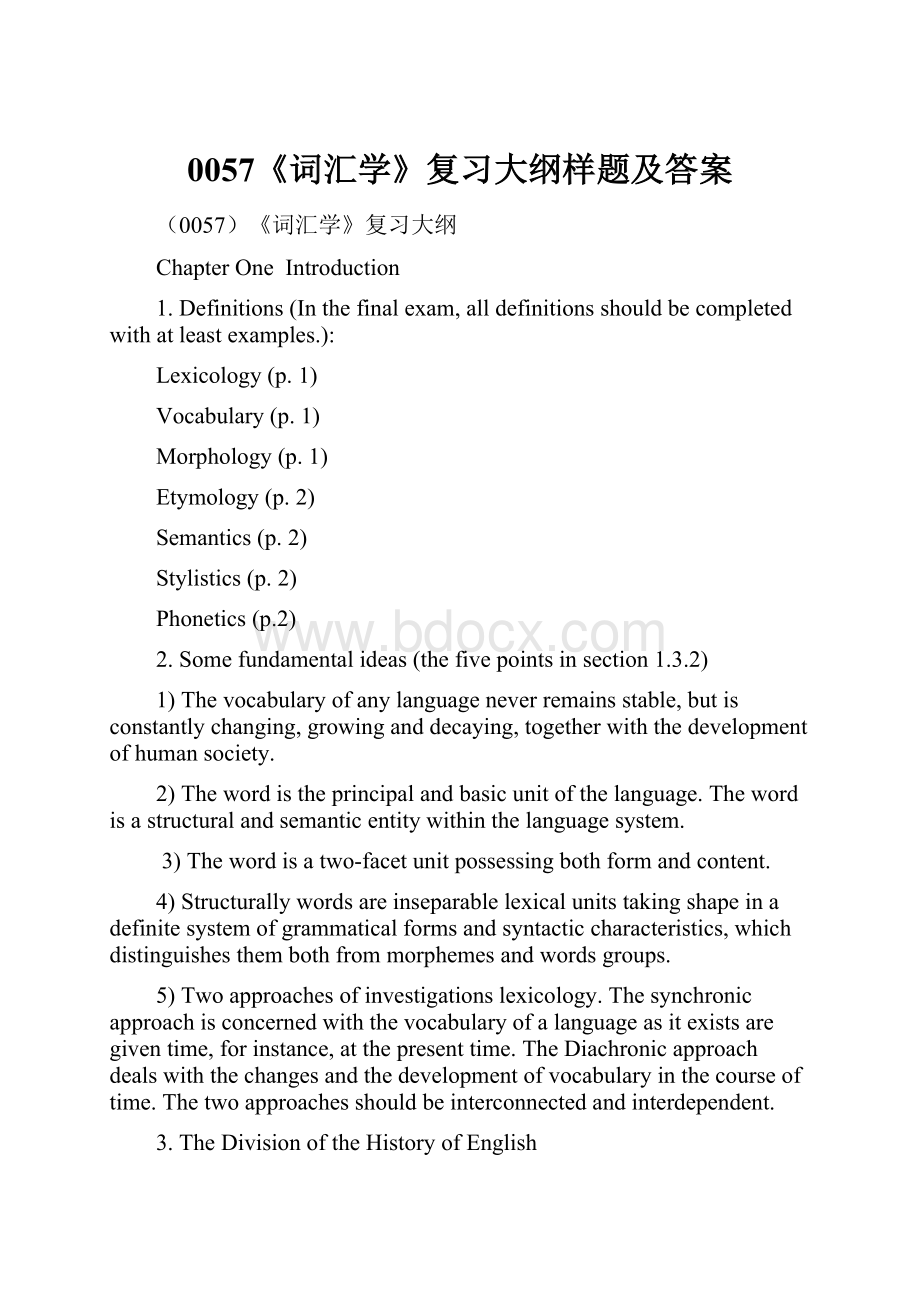0057《词汇学》复习大纲样题及答案.docx
《0057《词汇学》复习大纲样题及答案.docx》由会员分享,可在线阅读,更多相关《0057《词汇学》复习大纲样题及答案.docx(12页珍藏版)》请在冰豆网上搜索。

0057《词汇学》复习大纲样题及答案
(0057)《词汇学》复习大纲
ChapterOneIntroduction
1.Definitions(Inthefinalexam,alldefinitionsshouldbecompletedwithatleastexamples.):
Lexicology(p.1)
Vocabulary(p.1)
Morphology(p.1)
Etymology(p.2)
Semantics(p.2)
Stylistics(p.2)
Phonetics(p.2)
2.Somefundamentalideas(thefivepointsinsection1.3.2)
1)Thevocabularyofanylanguageneverremainsstable,butisconstantlychanging,growinganddecaying,togetherwiththedevelopmentofhumansociety.
2)Thewordistheprincipalandbasicunitofthelanguage.Thewordisastructuralandsemanticentitywithinthelanguagesystem.
3)Thewordisatwo-facetunitpossessingbothformandcontent.
4)Structurallywordsareinseparablelexicalunitstakingshapeinadefinitesystemofgrammaticalformsandsyntacticcharacteristics,whichdistinguishesthembothfrommorphemesandwordsgroups.
5)Twoapproachesofinvestigationslexicology.Thesynchronicapproachisconcernedwiththevocabularyofalanguageasitexistsaregiventime,forinstance,atthepresenttime.TheDiachronicapproachdealswiththechangesandthedevelopmentofvocabularyinthecourseoftime.Thetwoapproachesshouldbeinterconnectedandinterdependent.
3.TheDivisionoftheHistoryofEnglish
1)TheOldEnglish(Anglo-Saxon)period
Duration:
roughlyfrom450-1150
ThethreecharacteristicsofOldEnglish(page7-8)
(1)pronunciationdifference;
(2)Teutonicvocabulary;(3)fullofinflectional
2)TheMiddleEnglishperiod
Duration:
1150-1500
ThethreeCharacteristicsofMiddleEnglish(page8)
(1)resemblancetoOldEnglish;
(2)borrowingandlossinvocabulary;(3)lessinflectional
3)TheModernEnglishperiod(page8)
EarlyModernEnglish(1500-1700)
LateModernEnglish(Since1700)
ChapterTwoSourcesofEnglishVocabulary
1.ThenaiveelementsofEnglishVocabulary
1)Theninecharacteristicsofthenativeelement(pp.10-11)
a.all-nationalcharacter
b.greatstability
c.mono-syllabicwords
d.Greatword-formingability
e.widecollocability
f.pluralityofmeanings
g.highfrequencyvalue
h.stylisticallyneutral
2.TheforeignelementsofEnglishVocabulary(pp.11-26)
1)ThethreewaysoftheforeignelementsenteringintotheEnglishvocabulary(p.12)
a.throughoralspeech
b.throughwrittenspeech
c.throughinvaders
2)Classificationoftheforeignborrowings(or,thefourtypesofforeignelementsinEnglishvocabulary)(pp.12-13)
a.aliens;b.denizens;c.translationloan;d.semanticloan
3)SomeusefulLatinphrasesandabbreviations
viceversa,percent,percap.,personanongrata;a.m.,p.m.,i.e.,e.g.,c.f.,viz.
4)doublets,hybridsandinternationalwordsinEnglish(pp.26-30)
5)Thethreetypesofassimilatedwords:
completelyassimilatedwords,partlyassimilatedwordsandnon-assimilatedwords.(pp.32-33)
ChapterThreeWord-Building
1.Definitions(Inthefinalexam,alldefinitionsshouldbecompletedwithexamples.):
morpheme,freemorpheme,boundmorpheme,root,stem
2.Waysofword-building(attentionsshouldalsobepaidtotheexamplesappearingthewaysofword-building)
1)affixation(pp.39-51)
2)conversion(pp.51-55)
3)compounding(pp.55-59)
4)backformation(pp.59-60)
5)shortening(pp.60-63)
6)blending(pp.63-64)
7)imitation(p.64)
3.Alltheexercisesofthischapterarepossiblesourcesforthefinalexam!
ChapterFourSemantics
1.definitions(Inthefinalexam,alldefinitionsshouldbecompletedwithexamples.):
polysemy(p.72),homonymy(p.77),perfecthomonym(p.77),homograph(p.78),homophonep.78),synonym(p.80),antonym(p.86),
2.importantpoints
1)therelationbetweenawordanditsmeaning(p.70)
2)therelationbetweenwordsandconcepts(p.70-71)
3)themeaningof“nice”(p.72)
4)typesofsynonyms(pp.83-84)
5)theoriginofsynonyms(p.84)
6)theexamplewordsofantonym(pp.86-88)
7)waysofcoiningneologism(p.91)
8)theexercisesofChapterFour(pp.94-100)
ChapterFiveChangeofMeaning
1.Definitions(Inthefinalexam,alldefinitionsshouldbecompletedwithexamples.):
extensionofmeaning(p.101),narrowingofmeaning(p.102),degradationofmeaning(p.104),metonymy(p.114),synecdoche(p.116),oxymoron(p.119)
2.Alltheexercisesofthischapterarepossiblesourcesforthefinalexam!
ChapterSixEnglishIdioms
1.CharacteristicsofEnglishidioms(fourpoints)(pp.124-128)
2.Characteristicsofphrasalverbs(threepoints)(pp.133-134)
3.Alltheexercisesofthischapterarepossiblesourcesforthefinalexam!
ChapterSevenVarietiesofEnglish
1.Definitions(Inthefinalexam,alldefinitionsshouldbecompletedwithexamples.):
slang(p.149),jargon(p.149),
2.Alltheexercisesofthischapterarepossiblesourcesforthefinalexam!
ChapterEightAmericanEnglish
1.CharacteristicsofAmericanEnglish(pp.158-162)
2.DifferencesbetweenBritishEnglishandAmericanEnglish(pp.162-164)
3.Alltheexercisesofthischapterarepossiblesourcesforthefinalexam!
ChapterNineApplicationandComprehension
1.Attentionshouldbepaidtotheexamplewordsgiveninthischapter
2.Alltheexercisesofthischapterarepossiblesourcesforthefinalexam!
ChapterTenEnglishLexicography
1.Definitions(Inthefinalexam,alldefinitionsshouldbecompletedwithexamples.):
monolingualdictionary(p.185),bilingualdictionary(p.185),encyclopedia(p.186),encyclopedicdictionary(p.186).
(0057)《词汇学》样题
PartIDefinition(15points)
Directions:
Definingthefollowingtermswithexamples.
1.aliens
2.homophone
3.jargon
4.compounding
5.bilingualdictionary
PartIITrueorFalseDecision(15points)
Directions:
DecidewhetherthefollowingstatementsareT(true)orF(false).
1.Everywordhastwoaspects:
theouteraspect—writtenformandtheinneraspect—sound.
2.Someaffixesarefreemorphemeswhilesomeothersareboundmorphemes.
3.OldEnglishisalanguageoffullinflections.
4.“Popularwords”mainlyrefertowordsofFrenchoriginintheEnglishlanguage.
5.Strictlyspeaking,intheEnglishlanguage,therearenotwowordswhichareabsolutelyidenticalinmeaning
6.Weshouldputourhandsonthedeck,whenwehear“Allhandsondeck”onaboat.
7.Intheword“modify”,therootis“mod”,thestemis“modi”andthesuffixis“-fy”.
8.MostoftheaffixesarederivedfromOldEnglish,orfromLatinandGreek.
9.Inthecompoundword“bloodtest”,thesecondpart,i.e.“test”,indicatestheactionuponthefirstpart.
10.Absolutesynonymscanbefoundinordinarylife,e.g.begin—commence.
11.Simile,metaphorandpersonificationarefiguresofspeechbasedonresemblances.
12.Phonologically,compoundscanoftenbeidentifiedashavingamainstressonthefirstelementandsecondarystressonthesecondelement.
13.Actualmeaningreferstothemeaningofanisolatedwordinadictionary.
14.MostoftheEnglishwordsarepolysemic.
15.AmericanEnglishischaracterizedbycreativenessbutnotconservativenessinusage.
PartIIIMultipleChoice(15points)
Directions:
Thereare15sentencesinthissection.Beneatheachsentencethereare4wordsorphrasesmarkedA,B,C,andD.Choosetheonewordorphrasethatcorrectlycompletesthesentence.
1.Theword“question”isawordborrowedfrom.
A.LatinB.FrenchC.GreekD.Scandinavian
2.Heiswiseenoughtoseeallthesefinepretensions.
A.outB.toC.throughD.over
3.Youshouldrememberthatthebuildingisawarmemorialandspeakmore.
A.respectivelyB.respectablyC.respectfullyD.respected
4.ThecrownjewelsarekeptintheTowerofLondon.
A.valuedB.valuelessC.invaluableD.usable
5.Whenthecrowdsawtheprize-fighterstretchedoutonthecanvas,shoutsandcheersfromit.
A.brokeupB.brokeforthC.brokethroughD.breakupon
6.Thescientistsrealizeditwouldbetootoshipallpeopleinoneboat
becauseitwasfragile.
A.boldB.daringC.riskyD.dangerous
7.Theenergygainedfromthesuncanthenbeusedduringthenighttoenablethenecessarychemicalreactionstoinhisbody.
A.precedeB.proceedC.progressD.practise
8.ThereisaofvegetablesinShanghaiatthemomentbecauseofthecoldweather.
A.shortageB.wantC.needD.desire
9.WhentheVictorianshadfamilyreunions,thehostswenttheirwaytoentertaintheguests.
A.inforB.overC.outofD.backon
10.Havingpushedherson,Evegavehimadismissivetowardsthecar.
A.pushB.pullC.drawD.drag
11.Whichofthefollowingusuallyappearsinpoems?
A.horseB.steedC.gee-geeD.nag
12.WhichofthefollowingwordsisINCORROCTinwordformation?
A.unhorseB.unmannedC.unfrostD.unhappy
13.Whichofthefollowingisformedbyblending?
A.popB.sightseeC.copterD.boatel
14.Theantonymof“fresh”in“freshbread”is________.
A.staleB.stuffyC.fadedD.tired
15.Iwilltakeyoutoamostinteresting________ofnineteenthcentury.
A.wonderB.exhibitionC.expositionD.display
PartIVTranslation(10points)
Directions:
TranslatingthefollowingsentencesintoChinese.
1.Theseahassmootheddown.
2.KissingergottheplansandhelicopteredtoCampDavid.
3.Hecommandedafleetofthirtysails.
4.Strikewhiletheironishot.
5.Mostofthecityfamilieshaveafridge.
PartVAnswerthefollowingquestionswithexamples(15points)
1.WhataretheclassificationsofHomonyms?
(7points)
2.WhatarethecharacteristicfeaturesofEnglishidioms?
(8points)]
(0057)《词汇学》样题答案
PartIDefinition(15point